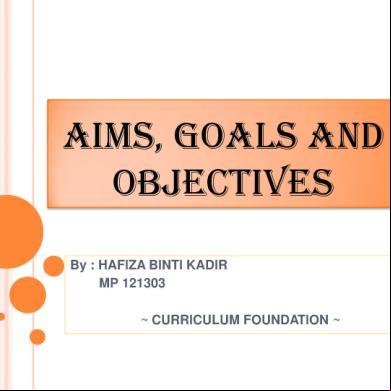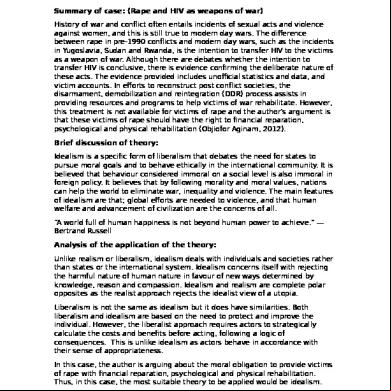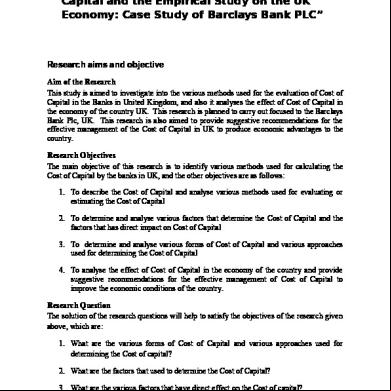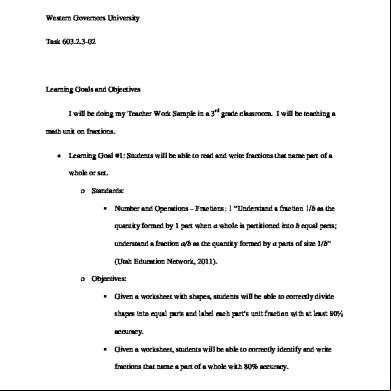Aims, Goals And Objectives 445rk
This document was ed by and they confirmed that they have the permission to share it. If you are author or own the copyright of this book, please report to us by using this report form. Report 3b7i
Overview 3e4r5l
& View Aims, Goals And Objectives as PDF for free.
More details w3441
- Words: 892
- Pages: 24
AIMS, GOALS AND OBJECTIVES By : HAFIZA BINTI KADIR MP 121303 ~ CURRICULUM FOUNDATION ~
THE PROBLEMS OF ENDS AND MEANS
Discourages the examinations of consequences and therefore the intelligent generation of alternate purpose
It renders men careless in their inspection of existing conditions
Fixing upon goals as terminal points outside the flow of human activity can in extreme cases result in arrogance and fanaticism
SOURCES OF AIMS, GOALS AND OBJECTIVES Empirical sources Philosophical sources
Subject matter sources
• Studies of the society • Studies of learners • Empirical sources told ‘what is’ but philosophical inquiry is necessary to help us decide what ‘ought to be’ • Open to rather serious criticism on the grounds that the objectives it generates tend to be exceedingly specialized, narrow and technical.
LEVELS OF OBJECTIVES
Relationships of aims, goals and objectives
Purposes and the anatomy of the target
Curriculum aims
Curriculum objectives
Curriculum goals
CURRICULUM AIMS Statements that describes expected life outcomes based on some value scheme either concious or unconciously borrowed from philosophy
Do not relate directly to school or classroom outcome, this is as targets.
The degree of their achievement is determinable only in the part of life well after the completion of school.
CURRICULUM GOALS While goals may refer to school outcomes specefied at the individual school level, they will more often reflect goals of a school system.
Will vary as to their degree of specificity but in general will tend to be long range in nature
As targets somewhat removed from what ordinarily is considered immediate classroom assessment
CURRICULUM OBJECTIVES The most immediate specific outcomes of classroom instruction
Refer to the everyday business of the operative currriculum and the degree to which they have been achieved is assessable
As targets, curriculum objectives are closed and quite visible
RELATIONSHIP OF AIMS, GOALS AND OBJECTIVES Can be considerable help in organizing a curriculum into a logical and coherent structure.
Distance between a curriculum objective and a curriculum goal is GREAT, between objective and aim is ENORMOUS
GREATEST PROBLEM : once commited, need to maintain a justifiable congruence from aims through goals to objective and to demonstrate the relationship of the required school tasks (objective and goals) and the desire life tasks (aims)
CLASSIFICATION OF AIMS, GOALS AND OBJECTIVES
Aims
Goals and objectives
AIMS
1. Central value pattern
2. A preferred social organization
3. An explication of preferred social rules
4. A preferred lifestyle
AIMS Health Command of fundamental process
Ethical character
Worthy use of leisure
7 Major Areas To Identify Curriculum Aims
Civic education
Vocational education
Worthy home hip
TAXONOMY OF EDUCATIONAL OBJECTIVES
Cognitive Domain • Knowledge • Comprehension • Application • Analysis • Synthesis • Evaluation
TAXONOMY OF EDUCATIONAL OBJECTIVES
Affective Domain • Receiving • Responding • Valuing • Organization • Characterization
TAXONOMY OF EDUCATIONAL OBJECTIVES
Psychomotor Domain • Observing • Imitating • Practicing • Adapting
THE USE OF TAXONOMIES Contributed most significantly to the refinement measurement techniques and thus to the evaluation of curriculum outcomes
To effect a balance in the curriculum with respect to intellectual, attitudinal and motor outcomes
Analyses provided help to maintain a logical consistency from general aims to specific objectives and
BEHAVIORAL OBJECTIVES
The Nature Of Behavioral Objectives Operationalism : The process of consciously specifying those unambigous observable indices that imply the existence of the construct wish to identify
Behaviorizing objectives : Simply objectives stated in term of the observable behavior expected of student after instruction
Uses and limitations of behavioral objectives
TRAINING VERSUS EDUCATION Perspectives on Training and Education Education : The Humanistic Model
Training : The Technical Model
EDUCATION : THE HUMANISTIC MODEL
Curriculum would be structured around openness
Outcomes would tend to be stated in humanistic rather than behavioral , and
The behavioral psychology of the training paradigm would be supplanted by the ‘self’ or ‘existential’ psychology of Abraham Maslow or Carl Rogers
TRAINING : THE TECHNICAL MODEL Specify objectives
Evaluate outcome
Preassess learners
Apply instruction
TRAINING : THE TECHNICAL MODEL Curriculum include a hierarchical, highly organized statement of outcomes framed in behavioral
Focus of training is efficient modification, behavioral psychology and reinforcement.
The motivation and behaviour change of learners , teacher would function in the role of skilled technician.
HOW AIMS, GOALS AND OBJECTIVES FUNCTION IN THE DETERMINATION OF CURRICULUM
Conceived and Operative Purposes
Intended and Unintended Outcomes
CONCEIVED AND OPERATIVE PURPOSES The resolution of the apparent contradiction has to do with an important distinction in curriculum goals : • Goals which schools in fact attempt to achieve • Goals at which schools think they ought to be aiming
Distinction between ‘is and ought’ in curriculum goals present two problems with which must wrestle: • Ensure the goals are consonant with all of its other components • Aware the process of implementation, goals which may represent the ‘ought’ are easily subverted in the direction of ‘is’
INTENDED AND UNINTENDED OUTCOMES
By concerning determining the degree to which stated purposes have been achieved, leave entirely in the dark with respect to a whole range of consequences unshered in by the implementation of curriculum
Eg : goal – specified level of reading proficiency. Evaluation indicates highly successful in attaining the goal, curriculum is judge to be effective
Evaluated for intended outcomes, might be an unintended(undesire d) consequence of the curriculum (aversion to reading)
THAT’S ALL FROM ME.. THANKS FOR LISTENING AND UNDERSTANDING.. Lots of appreciation…..
THE PROBLEMS OF ENDS AND MEANS
Discourages the examinations of consequences and therefore the intelligent generation of alternate purpose
It renders men careless in their inspection of existing conditions
Fixing upon goals as terminal points outside the flow of human activity can in extreme cases result in arrogance and fanaticism
SOURCES OF AIMS, GOALS AND OBJECTIVES Empirical sources Philosophical sources
Subject matter sources
• Studies of the society • Studies of learners • Empirical sources told ‘what is’ but philosophical inquiry is necessary to help us decide what ‘ought to be’ • Open to rather serious criticism on the grounds that the objectives it generates tend to be exceedingly specialized, narrow and technical.
LEVELS OF OBJECTIVES
Relationships of aims, goals and objectives
Purposes and the anatomy of the target
Curriculum aims
Curriculum objectives
Curriculum goals
CURRICULUM AIMS Statements that describes expected life outcomes based on some value scheme either concious or unconciously borrowed from philosophy
Do not relate directly to school or classroom outcome, this is as targets.
The degree of their achievement is determinable only in the part of life well after the completion of school.
CURRICULUM GOALS While goals may refer to school outcomes specefied at the individual school level, they will more often reflect goals of a school system.
Will vary as to their degree of specificity but in general will tend to be long range in nature
As targets somewhat removed from what ordinarily is considered immediate classroom assessment
CURRICULUM OBJECTIVES The most immediate specific outcomes of classroom instruction
Refer to the everyday business of the operative currriculum and the degree to which they have been achieved is assessable
As targets, curriculum objectives are closed and quite visible
RELATIONSHIP OF AIMS, GOALS AND OBJECTIVES Can be considerable help in organizing a curriculum into a logical and coherent structure.
Distance between a curriculum objective and a curriculum goal is GREAT, between objective and aim is ENORMOUS
GREATEST PROBLEM : once commited, need to maintain a justifiable congruence from aims through goals to objective and to demonstrate the relationship of the required school tasks (objective and goals) and the desire life tasks (aims)
CLASSIFICATION OF AIMS, GOALS AND OBJECTIVES
Aims
Goals and objectives
AIMS
1. Central value pattern
2. A preferred social organization
3. An explication of preferred social rules
4. A preferred lifestyle
AIMS Health Command of fundamental process
Ethical character
Worthy use of leisure
7 Major Areas To Identify Curriculum Aims
Civic education
Vocational education
Worthy home hip
TAXONOMY OF EDUCATIONAL OBJECTIVES
Cognitive Domain • Knowledge • Comprehension • Application • Analysis • Synthesis • Evaluation
TAXONOMY OF EDUCATIONAL OBJECTIVES
Affective Domain • Receiving • Responding • Valuing • Organization • Characterization
TAXONOMY OF EDUCATIONAL OBJECTIVES
Psychomotor Domain • Observing • Imitating • Practicing • Adapting
THE USE OF TAXONOMIES Contributed most significantly to the refinement measurement techniques and thus to the evaluation of curriculum outcomes
To effect a balance in the curriculum with respect to intellectual, attitudinal and motor outcomes
Analyses provided help to maintain a logical consistency from general aims to specific objectives and
BEHAVIORAL OBJECTIVES
The Nature Of Behavioral Objectives Operationalism : The process of consciously specifying those unambigous observable indices that imply the existence of the construct wish to identify
Behaviorizing objectives : Simply objectives stated in term of the observable behavior expected of student after instruction
Uses and limitations of behavioral objectives
TRAINING VERSUS EDUCATION Perspectives on Training and Education Education : The Humanistic Model
Training : The Technical Model
EDUCATION : THE HUMANISTIC MODEL
Curriculum would be structured around openness
Outcomes would tend to be stated in humanistic rather than behavioral , and
The behavioral psychology of the training paradigm would be supplanted by the ‘self’ or ‘existential’ psychology of Abraham Maslow or Carl Rogers
TRAINING : THE TECHNICAL MODEL Specify objectives
Evaluate outcome
Preassess learners
Apply instruction
TRAINING : THE TECHNICAL MODEL Curriculum include a hierarchical, highly organized statement of outcomes framed in behavioral
Focus of training is efficient modification, behavioral psychology and reinforcement.
The motivation and behaviour change of learners , teacher would function in the role of skilled technician.
HOW AIMS, GOALS AND OBJECTIVES FUNCTION IN THE DETERMINATION OF CURRICULUM
Conceived and Operative Purposes
Intended and Unintended Outcomes
CONCEIVED AND OPERATIVE PURPOSES The resolution of the apparent contradiction has to do with an important distinction in curriculum goals : • Goals which schools in fact attempt to achieve • Goals at which schools think they ought to be aiming
Distinction between ‘is and ought’ in curriculum goals present two problems with which must wrestle: • Ensure the goals are consonant with all of its other components • Aware the process of implementation, goals which may represent the ‘ought’ are easily subverted in the direction of ‘is’
INTENDED AND UNINTENDED OUTCOMES
By concerning determining the degree to which stated purposes have been achieved, leave entirely in the dark with respect to a whole range of consequences unshered in by the implementation of curriculum
Eg : goal – specified level of reading proficiency. Evaluation indicates highly successful in attaining the goal, curriculum is judge to be effective
Evaluated for intended outcomes, might be an unintended(undesire d) consequence of the curriculum (aversion to reading)
THAT’S ALL FROM ME.. THANKS FOR LISTENING AND UNDERSTANDING.. Lots of appreciation…..







